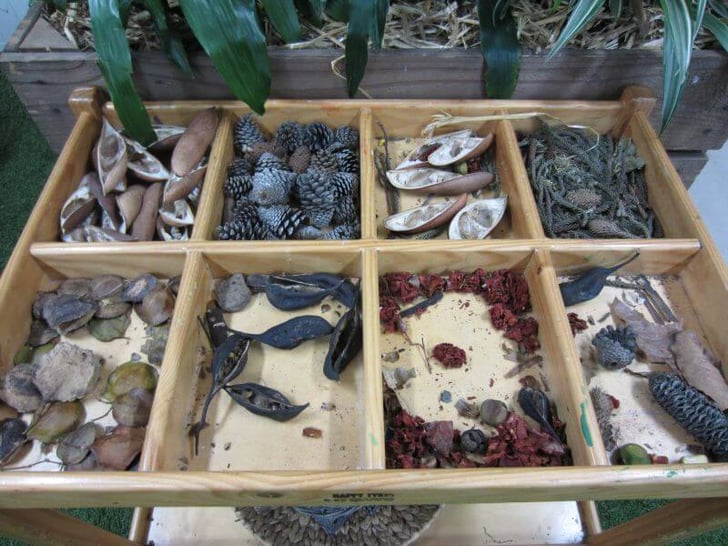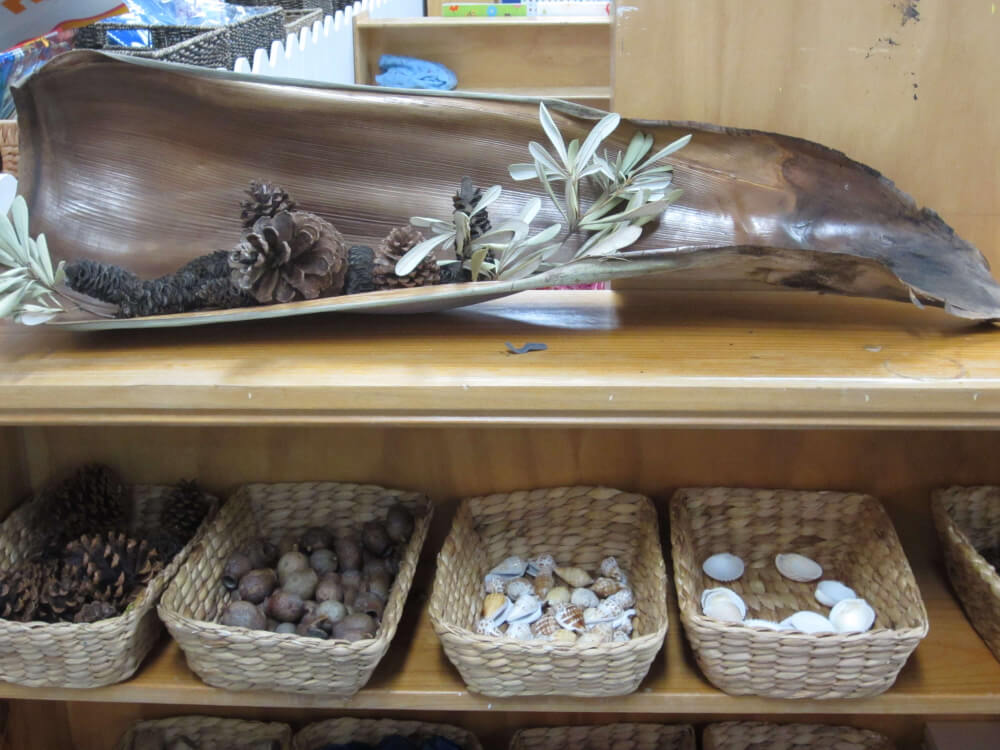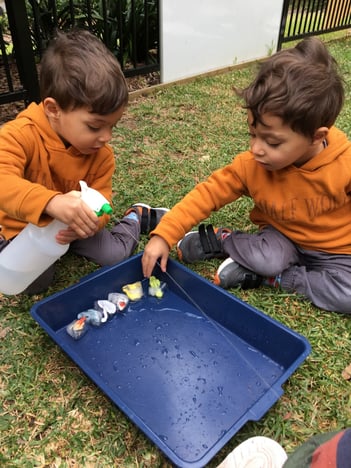Have you ever looked at a bunch of pine cones and thought about how they would make the perfect bodies for a family of hedgehogs? Or seen the potential in a bunch of sticks, rocks and leaves to become the world's fastest rocket ship? Probably not. But your children surely have.
The beauty of children is that they see possibilities in everything. Objects are never just one thing. There is a joy in how they can take a seemingly disparate collection of found objects and create something incredible, all with just the power of their imagination.
As early childhood educators, we know the power loose parts play in unleashing creativity and encouraging problem-solving. We know that the learning environment is enriched when children can explore open-ended materials.
We've broken it down for you to help you understand what it is, why it matters and how to welcome loose parts play into your routine.

What is Loose Parts Play?
The loose parts play theory is based on the idea that when children are presented with a collection of small objects (i.e. loose parts), they have more opportunities for creativity and engagement as they rearrange, redesign and tinker with the parts, creating patterns and new objects as they go. Architect Simon Nicholson developed the theory in the early 1970s.
Loose parts play is likely how your children naturally play. They collect bits and bobs from around them and bring them together to create something new. When we talk about loose parts play in an educational or more structured setting, it's about giving children more of these opportunities to explore and develop their innate creativity.
The Benefits of Loose Parts Play
As adults, when we're caught up in our busy days, it's easy to think of loose parts play as busy work or something to keep the kids occupied. But it's so much more than that. In truth, loose parts play is a crucial piece of the puzzle in the developmental skills your child needs as they learn and grow.
You might be surprised to learn what some of those benefits are and how beneficial playing with random materials can be for young children. Some of the benefits include:
- Developing a sense of independence as children have the freedom to explore different materials autonomously.
- Encouraging language development as children communicate their ideas and knowledge with their peers, educators, parents and carers.
- Building creative thinking, problem-solving, curiosity and abstract thinking skills as children explore the materials and discover new ways of playing with them.
- Enhancing fine motor skills as children pick up, hold and manipulate materials in multiple ways.
- Facilitating collaboration, sharing and belonging as children interact with others around them engaged in the play.
- Increasing physical play and activity along with gross motor skills as children move and transfer their creations and use them in further imaginative play.

How Playing with Loose Parts Benefits Children's Learning
In many ways, playing with loose parts gives your children the building blocks they need for so many other skills, both cognitive and physical.
Holding a pencil to start writing or picking up a pair of scissors to cut doesn't just happen. First children start by picking up small objects - beads, a stick or other materials. They gradually move onto bigger objects or even learn how to manipulate tweezers to pick up small pieces of paper.
Through playing with loose parts they are learning the early concepts of engineering and physics - about weight, density and how things work.
They take their ideas and turn them into physical phenomena, engaging in early forms of storytelling as they place different objects together.
Best of all, this type of play is led by the child. You create the learning environment and then they take over. Children love to be independent. They are natural learners and playing with loose parts taps into this to help them learn in an open-ended way.
How Loose Parts Play Benefits Teachers... and Teaching
As early childhood teachers, we love nothing more than seeing children develop and discover new interests and ideas. It's our job to nurture a child's passions and talents in a safe and respectful learning environment.
Loose parts play allows us to create environments and provide resources and then let the kids take over. In this way, we can give each of the children in our care exactly what they need. Some kids have an idea and run with it. Other children need some support to help bring their idea to life. Loose parts play helps us to uncover those differences and tailor the experience to each child.
This type of play also helps us to uncover areas for development such as particular fine motor skills.
Loose Parts Focused Strategies and Approaches
Loose parts play is as complex as you make it. Start with the basics and go from there. You don't need to have the biggest collection of materials to make it work. Here's what you need to consider.
Organising for Loose Parts Play
Loose parts organisation is about keeping it simple. You can store your loose parts in buckets or small containers that can also double as loose parts.
You can choose to separate the loose parts resources into categories or simply keep them all together in one box. It's whatever works with your life and the same in your home.
Loose Parts Materials
One of the best things about this type of play is that it's relatively inexpensive. You don't need to buy expensive toys - you can find many of the loose parts materials around your house or out in nature. The possibilities are endless!
While not an exhaustive list, here are some ideas to spark your thinking:
- natural materials such as pine cones, sticks, rocks and leaves
- craft items such as pipe cleaners, beads, buttons, sequins, cotton reels, paddle pop sticks and feathers
- household items such as egg cartons, bottle caps, milk carton lids, paper towel and toilet paper tubes
- wooden items such as wood scraps or wooden blocks
All these things can be easily collected from around the home. You can even ask local businesses if they have scraps of wood or other items that they are happy to donate. As you come across new objects you can add to your stash.
.jpg?width=385&name=Saltwater_childcare%20(3%20of%2016).jpg) Loose Parts and Open-Ended Learning
Loose Parts and Open-Ended Learning
Open-ended learning and loose parts play are connected concepts that both offer similar outcomes - allowing kids to discover their world and have fun with the process.
With open-ended learning, children are encouraged to learn without set parameters or rules. There is no right or wrong answer or way of doing things. Loose parts play is much the same. Two kids can be presented with the same collection of loose parts and create two completely different things. Neither is right or wrong. Both are free to make the learning experiences their own.
Loose Parts within the Curriculum
The theory of loose parts play is one thing, but how does it work in practice in the learning environment? Within our curriculum, we use loose parts in a range of different key learning areas to enhance the learning and make it fun!
Maths
Within maths, we might encourage children to collect and count loose parts or to arrange them in patterns. Sorting objects into colours, sizes or shapes or even matching like items are all early maths skills.
Science
Loose parts experiments can be loads of fun. Which items float or sink in water? What happens if you try to put a large block on top of a smaller one? What shadows do different loose parts cast? What are different loose parts made of and what properties do different materials have?
Language and Literacy
As children start to describe the loose parts in front of them or what they have created with those parts, it helps to build their language skills. Combined with the power of early storytelling experiences, literacy skills can also be enhanced.
Art, Movement and Music
Children can use loose parts within artworks or as tools to create that art. A leaf can be dipped in paint and pressed onto a page or a feather can be used as a paintbrush. Children love to make music and can create their own musical instruments to move and dance with. They can also learn from using things such as scarves or ribbons to observe how they move when they dance.
 Loose Parts Learning Outcomes
Loose Parts Learning Outcomes
We use loose parts play to help in meeting all five of the learning outcomes in the Early Years Learning Framework.
Outcome 1: Children have a strong sense of identity.
We encourage children to express their individuality and express themselves within loose parts play. They are free to take risks within a safe and nurturing environment.
Outcome 2: Children are connected with and contribute to their world.
Using items found in nature we connected children to their natural world and also foster community amongst the peer group as they discover and learn together.
Outcome 3: Children have a strong sense of well-being.
By being allowed to express themselves and work collaboratively or autonomously in a safe environment we are caring for the children's wellbeing.
Outcome 4: Children are confident and involved learners.
As these experiences cater to the individual preferences of each child, they can engage in learning in a way that suits their personality and interests. This gives them the confidence to ask questions and take risks, both skills they need to be confident and involved learners.
Outcome 5: Children are effective communicators.
Explaining their creations, asking questions about items and learning about sharing or give and take helps to embed and develop important communication skills.
Loose Parts Ideas and Resources
When it comes to loose parts play there is a world of possibilities. You can set up endless invitations to play or simply hand over the loose parts and let them go wild.
We encourage families to speak with your educator if you have any questions about loose parts play and how we use it in the Gowrie NSW centres. Your educator can also give you ideas for your child to make the most of loose parts play at home.







